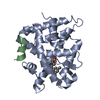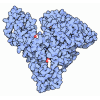| 登録情報 | データベース: PDB / ID: 4poh
|
|---|
| タイトル | Crystal structure of human Retinoid X Receptor alpha-ligand binding domain complex with 8-methyl UAB30 and the coactivator peptide GRIP-1 |
|---|
 要素 要素 | - Nuclear receptor coactivator 2
- Retinoic acid receptor RXR-alpha
|
|---|
 キーワード キーワード | TRANSCRIPTION / ligand binding domain / nuclear receptor / cancer / methyl substituted rexinoid / 8-methyl UAB30 |
|---|
| 機能・相同性 |  機能・相同性情報 機能・相同性情報
retinoic acid-responsive element binding / NR1H2 & NR1H3 regulate gene expression linked to triglyceride lipolysis in adipose / NR1H2 & NR1H3 regulate gene expression linked to gluconeogenesis / NR1H2 & NR1H3 regulate gene expression to limit cholesterol uptake / positive regulation of thyroid hormone receptor signaling pathway / NR1H2 & NR1H3 regulate gene expression linked to lipogenesis / Carnitine shuttle / retinoic acid binding / TGFBR3 expression / positive regulation of vitamin D receptor signaling pathway ...retinoic acid-responsive element binding / NR1H2 & NR1H3 regulate gene expression linked to triglyceride lipolysis in adipose / NR1H2 & NR1H3 regulate gene expression linked to gluconeogenesis / NR1H2 & NR1H3 regulate gene expression to limit cholesterol uptake / positive regulation of thyroid hormone receptor signaling pathway / NR1H2 & NR1H3 regulate gene expression linked to lipogenesis / Carnitine shuttle / retinoic acid binding / TGFBR3 expression / positive regulation of vitamin D receptor signaling pathway / nuclear vitamin D receptor binding / Signaling by Retinoic Acid / RNA polymerase II intronic transcription regulatory region sequence-specific DNA binding / DNA binding domain binding / NR1H2 & NR1H3 regulate gene expression to control bile acid homeostasis / LBD domain binding / locomotor rhythm / aryl hydrocarbon receptor binding / nuclear steroid receptor activity / cellular response to Thyroglobulin triiodothyronine / regulation of lipid metabolic process / regulation of glucose metabolic process / Synthesis of bile acids and bile salts / positive regulation of cholesterol efflux / Synthesis of bile acids and bile salts via 27-hydroxycholesterol / Endogenous sterols / Synthesis of bile acids and bile salts via 7alpha-hydroxycholesterol / response to retinoic acid / positive regulation of bone mineralization / cellular response to hormone stimulus / Recycling of bile acids and salts / Transcriptional regulation of brown and beige adipocyte differentiation by EBF2 / transcription regulator inhibitor activity / retinoic acid receptor signaling pathway / NR1H3 & NR1H2 regulate gene expression linked to cholesterol transport and efflux / hormone-mediated signaling pathway / : / positive regulation of adipose tissue development / Regulation of lipid metabolism by PPARalpha / peroxisome proliferator activated receptor signaling pathway / regulation of cellular response to insulin stimulus / peptide binding / BMAL1:CLOCK,NPAS2 activates circadian expression / SUMOylation of transcription cofactors / Activation of gene expression by SREBF (SREBP) / response to progesterone / nuclear receptor binding / transcription coregulator binding / negative regulation of smoothened signaling pathway / RNA polymerase II transcription regulatory region sequence-specific DNA binding / SUMOylation of intracellular receptors / circadian regulation of gene expression / mRNA transcription by RNA polymerase II / Heme signaling / Transcriptional activation of mitochondrial biogenesis / Activated PKN1 stimulates transcription of AR (androgen receptor) regulated genes KLK2 and KLK3 / PPARA activates gene expression / Cytoprotection by HMOX1 / Nuclear Receptor transcription pathway / Transcriptional regulation of white adipocyte differentiation / RNA polymerase II transcription regulator complex / Activation of anterior HOX genes in hindbrain development during early embryogenesis / Transcriptional regulation of granulopoiesis / nuclear receptor activity / sequence-specific double-stranded DNA binding / : / nervous system development / HATs acetylate histones / MLL4 and MLL3 complexes regulate expression of PPARG target genes in adipogenesis and hepatic steatosis / double-stranded DNA binding / transcription regulator complex / Estrogen-dependent gene expression / sequence-specific DNA binding / DNA-binding transcription factor activity, RNA polymerase II-specific / cell differentiation / transcription coactivator activity / receptor complex / transcription cis-regulatory region binding / protein dimerization activity / nuclear body / RNA polymerase II cis-regulatory region sequence-specific DNA binding / DNA-binding transcription factor activity / protein domain specific binding / chromatin binding / regulation of DNA-templated transcription / chromatin / positive regulation of DNA-templated transcription / enzyme binding / negative regulation of transcription by RNA polymerase II / positive regulation of transcription by RNA polymerase II / protein-containing complex / mitochondrion / zinc ion binding / nucleoplasm / identical protein binding / nucleus / cytoplasm / cytosol類似検索 - 分子機能 Nuclear/hormone receptor activator site AF-1 / Nuclear/hormone receptor activator site AF-1 / Retinoid X receptor/HNF4 / : / Nuclear receptor coactivator 2 / Nuclear receptor coactivator 2/3, DUF4927 / Domain of unknown function (DUF4927) / Nuclear receptor coactivator, DUF1518 / Nuclear receptor coactivator, Ncoa-type, interlocking / Nuclear receptor coactivator, Ncoa-type, interlocking domain superfamily ...Nuclear/hormone receptor activator site AF-1 / Nuclear/hormone receptor activator site AF-1 / Retinoid X receptor/HNF4 / : / Nuclear receptor coactivator 2 / Nuclear receptor coactivator 2/3, DUF4927 / Domain of unknown function (DUF4927) / Nuclear receptor coactivator, DUF1518 / Nuclear receptor coactivator, Ncoa-type, interlocking / Nuclear receptor coactivator, Ncoa-type, interlocking domain superfamily / Nuclear receptor coactivator, DUF1518 / Nuclear receptor coactivator / DUF1518 / Nuclear receptor coactivator, receptor-binding domain / Nuclear receptor coactivator / : / Steroid receptor coactivator / Unstructured region on nuclear receptor coactivator protein / Nuclear receptor coactivators bHLH domain / PAS domain / Nuclear receptor coactivator, interlocking / helix loop helix domain / Myc-type, basic helix-loop-helix (bHLH) domain / Myc-type, basic helix-loop-helix (bHLH) domain profile. / Helix-loop-helix DNA-binding domain superfamily / PAS fold / PAS fold / PAS domain / PAS repeat profile. / PAS domain / Retinoid X Receptor / Retinoid X Receptor / PAS domain superfamily / Nuclear hormone receptor / Nuclear hormones receptors DNA-binding region signature. / Zinc finger, nuclear hormone receptor-type / Double treble clef zinc finger, C4 type / Nuclear hormone receptors DNA-binding domain profile. / c4 zinc finger in nuclear hormone receptors / Nuclear hormone receptor, ligand-binding domain / Nuclear hormone receptor-like domain superfamily / Ligand-binding domain of nuclear hormone receptor / Nuclear receptor (NR) ligand-binding (LBD) domain profile. / Ligand binding domain of hormone receptors / Zinc finger, NHR/GATA-type / Orthogonal Bundle / Mainly Alpha類似検索 - ドメイン・相同性 Chem-2VR / Retinoic acid receptor RXR-alpha / Nuclear receptor coactivator 2類似検索 - 構成要素 |
|---|
| 生物種 |  Homo sapiens (ヒト) Homo sapiens (ヒト) |
|---|
| 手法 |  X線回折 / X線回折 /  分子置換 / 解像度: 2.3 Å 分子置換 / 解像度: 2.3 Å |
|---|
 データ登録者 データ登録者 | Xia, G. / Smith, C.D. / Muccio, D.D. |
|---|
 引用 引用 |  ジャーナル: J.Med.Chem. / 年: 2014 ジャーナル: J.Med.Chem. / 年: 2014
タイトル: Methyl substitution of a rexinoid agonist improves potency and reveals site of lipid toxicity.
著者: Atigadda, V.R. / Xia, G. / Desphande, A. / Boerma, L.J. / Lobo-Ruppert, S. / Grubbs, C.J. / Smith, C.D. / Brouillette, W.J. / Muccio, D.D. |
|---|
| 履歴 | | 登録 | 2014年2月25日 | 登録サイト: RCSB / 処理サイト: RCSB |
|---|
| 改定 1.0 | 2014年6月18日 | Provider: repository / タイプ: Initial release |
|---|
| 改定 1.1 | 2014年7月23日 | Group: Database references |
|---|
| 改定 1.2 | 2022年8月17日 | Group: Database references / Derived calculations
カテゴリ: database_2 / pdbx_struct_assembly ...database_2 / pdbx_struct_assembly / pdbx_struct_assembly_gen / pdbx_struct_assembly_prop / pdbx_struct_oper_list / struct_site
Item: _database_2.pdbx_DOI / _database_2.pdbx_database_accession ..._database_2.pdbx_DOI / _database_2.pdbx_database_accession / _pdbx_struct_assembly.details / _pdbx_struct_assembly.method_details / _pdbx_struct_assembly.oligomeric_count / _pdbx_struct_assembly.oligomeric_details / _pdbx_struct_assembly_gen.oper_expression / _struct_site.pdbx_auth_asym_id / _struct_site.pdbx_auth_comp_id / _struct_site.pdbx_auth_seq_id |
|---|
| 改定 1.3 | 2023年9月20日 | Group: Data collection / Refinement description
カテゴリ: chem_comp_atom / chem_comp_bond / pdbx_initial_refinement_model |
|---|
|
|---|
 データを開く
データを開く 基本情報
基本情報 要素
要素 キーワード
キーワード 機能・相同性情報
機能・相同性情報 Homo sapiens (ヒト)
Homo sapiens (ヒト) X線回折 /
X線回折 /  分子置換 / 解像度: 2.3 Å
分子置換 / 解像度: 2.3 Å  データ登録者
データ登録者 引用
引用 ジャーナル: J.Med.Chem. / 年: 2014
ジャーナル: J.Med.Chem. / 年: 2014 構造の表示
構造の表示 Molmil
Molmil Jmol/JSmol
Jmol/JSmol ダウンロードとリンク
ダウンロードとリンク ダウンロード
ダウンロード 4poh.cif.gz
4poh.cif.gz PDBx/mmCIF形式
PDBx/mmCIF形式 pdb4poh.ent.gz
pdb4poh.ent.gz PDB形式
PDB形式 4poh.json.gz
4poh.json.gz PDBx/mmJSON形式
PDBx/mmJSON形式 その他のダウンロード
その他のダウンロード 4poh_validation.pdf.gz
4poh_validation.pdf.gz wwPDB検証レポート
wwPDB検証レポート 4poh_full_validation.pdf.gz
4poh_full_validation.pdf.gz 4poh_validation.xml.gz
4poh_validation.xml.gz 4poh_validation.cif.gz
4poh_validation.cif.gz https://data.pdbj.org/pub/pdb/validation_reports/po/4poh
https://data.pdbj.org/pub/pdb/validation_reports/po/4poh ftp://data.pdbj.org/pub/pdb/validation_reports/po/4poh
ftp://data.pdbj.org/pub/pdb/validation_reports/po/4poh リンク
リンク 集合体
集合体

 要素
要素 Homo sapiens (ヒト) / 株: P19793 / 遺伝子: NR2B1, RXRA, RXRA NR2B1 / 発現宿主:
Homo sapiens (ヒト) / 株: P19793 / 遺伝子: NR2B1, RXRA, RXRA NR2B1 / 発現宿主: 
 Homo sapiens (ヒト) / 参照: UniProt: Q15596
Homo sapiens (ヒト) / 参照: UniProt: Q15596 X線回折 / 使用した結晶の数: 1
X線回折 / 使用した結晶の数: 1  試料調製
試料調製 回転陽極 / タイプ: OTHER / 波長: 1.5418 Å
回転陽極 / タイプ: OTHER / 波長: 1.5418 Å 解析
解析 分子置換
分子置換 ムービー
ムービー コントローラー
コントローラー








 PDBj
PDBj














